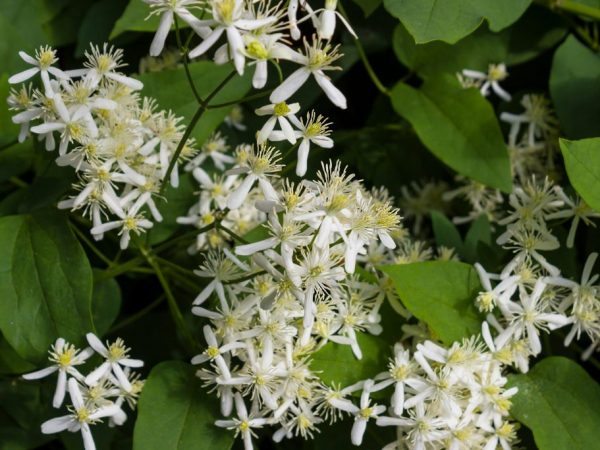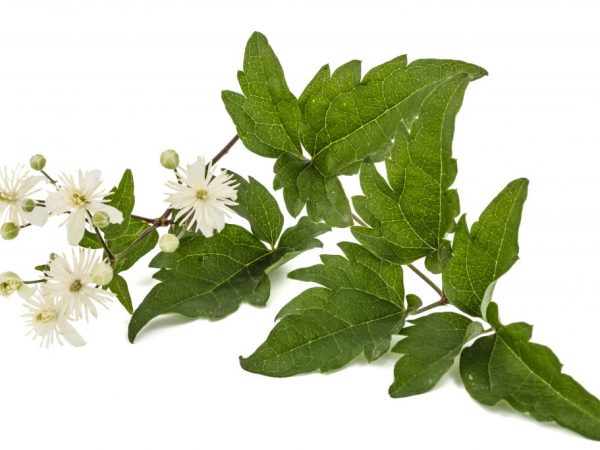What is clematis grape-leaved (clematis)
Grape-leaved clematis belongs to the buttercup family, the genus Clematis. This is an ornamental plant that is easy to care for. Predominantly wild, but sometimes cultivated. It is used in garden and park landscaping.

Clematis grape-leaved
Botanical characteristic
According to the description, clematis belongs to vines, it grows from the base for tens of meters. The total length depends on the varietal variety and the creation of favorable conditions. The plant has a strongly ribbed bark and branches that are subsequently covered with cracks. With the help of wriggling long leaf stalks, it clings to the supports.
Clematis is named grape-leaved because of its tendency to climb upward, clinging to the shoots on natural and artificial supports.
Foliage is opposite, complex, consists of 5 whole, in rare cases - three-lobed leaf blades. The leaves are ovoid, 3-10 cm long, 3-4.5 cm wide, pointed at the ends, rounded at the base. They usually have large teeth at the edges.
In nature, there are 2 types:
- herbaceous, dying off after one vegetative period,
- semi-shrub, wintering.
Clematis can have a thin rod or branched fibrous root system. It is small-flowered. The inflorescences are formed by flowers 2 cm in diameter, white in color, with a light aroma. The flowering period is June-July. The fruits of clematis are achenes measuring 7 * 44 mm. Flowering and seed formation begins in the third life cycle of the plant.
Growing places
The range of wild clematis covers an area from the North African region, starting with Algeria, stretching across almost the entire European territory, across the East European plain towards the Near and Middle East.
The plant has been naturalized in the Australian and North American territories. Today it is cultivated in the European part of Russia.
Preferred growing areas:
- shrub thickets,
- forest edges,
- rocky mountain slopes, up to 1.2 km above sea level.
Under conditions of artificial cultivation, active growth of clematis is noted on well-drained and well-nourished soil. He loves moisture, but not excess.
The chemical composition of the plant

The plant is poisonous
By its composition, clematis is poisonous, but its use for medicinal purposes is permissible if the dosage is observed. It contains:
- alphatocopherol, with a lack of which in the body there is a violation of oxidative processes, destruction of membranes, liver degradation begins, in women, a weakening of reproductive function develops,
- dehydroquinamic and chlorogenic acid compounds with bacteriostatic and choleretic properties,
- triterpene saponins,
- phenolcarbonate acids,
- steroid glycosides,
- essential oils,
- alkaloid clematine and glycoside clemantine,
- oleanolic acid,
- wax substances and other compounds that are beneficial to health when consumed in limited quantities.
Scope of application
Due to its rich chemical composition, grape-leaved clematis is widely used for medicinal purposes, since it is a medicinal plant. Preparations, which include clematis, are intended for the treatment of:
- headache,
- stomach ulcers
- sexually transmitted infections,
- bone tumors.
Grape-leaved Clematis is used as a diuretic, laxative and diaphoretic. Homeopathy uses clematis against conjunctivitis and cystitis.
The plant is widely used in landscape design for decorating garden plots and landscaping park areas.
Artificial cultivation care
A photophilous plant with artificial cultivation is planted in a shaded place, since in a sultry period, clematis foliage burns out and turns yellow from the excess of the sun. At the same time, the plant tolerates smoke and gas pollution well.
Landing
In regions where the temperature does not drop below -40 ° C in winter, seedlings are planted in autumn, in September-October. In more severe climatic areas, the plant is planted in the spring. The minimum distance between bushes when planting is 1-1.5 m.
Watering
In the process of leaving, grape-leaved clematis is watered only if necessary, with the onset of hot weather, with an interval of 5-7 days.
Fertilizer
Fertilization ensures abundant flowering of clematis. It is fed in spring with lime (200 g per 10 liters of water) and then once a month from May to the end of summer with ready-made fertilizer complexes, alternating them. The introduction of manure is acceptable.
Conclusion
The unpretentious small-flowered clematis grape-leaved (clematis) is used as a living decorative decoration for landscaping parks and garden plots. The supporting ability to stretch upwards makes it possible to form separate compositions from it and located on fences, use it as a shadow curtain, planting it to garden and park gazebos and verandas.


